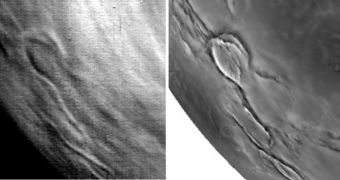For many years, Venus, the second planet from the Sun and the brightest object in the night sky, refused to let astronomers peak under its opaque layer of highly reflective clouds of sulfuric acid, preventing its surface from being seen from space in visible light.
Recent pictures taken by two missions designed to study the oddities of the densest atmosphere of all the terrestrial planets, consisting mostly of carbon dioxide, are now being analyzed and could produce valuable scientific results.
These pictures are a unique combination, representing the same areas of the clouds seen by both ESA's Venus Express and NASA's MESSENGER (MErcury Surface, Space ENvironment, Geochemistry and Ranging), on its swingby of the planet while on its way for Mercury.
Carrying different sets of instruments that also use different observation techniques, the two probes have complemented each other perfectly by focusing on the same regions seen from distinct locations above Venus.
Both observed a cloud moving west by about 90? longitude every day, making it visible to the two probes consecutively, in an interval of 12 hours, once on the day-side of the planet and another time on the night-side.
The cloud was selected due to the fact that it's a typical example of atmospheric structure at Venus, thus presenting a unique opportunity for researchers hoping to solve the puzzle of the Venusian atmosphere's dynamics and composition.
Hopefully, a complex set of visual, thermal and topographic observations will allow scientists to understand if the measured temperature of the surface depends on the altitude or if it relies on some mysterious heat sources that still remain undetected, like active volcanoes or other geological activities.
This joint observation is hoped to solve some of the mysteries of the hidden surface of Venus, with full analysis results being expected by the end of the year.

 14 DAY TRIAL //
14 DAY TRIAL //